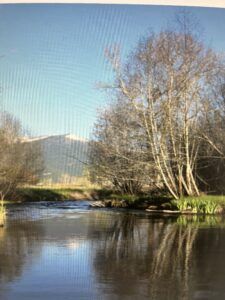
by Michael Howell
A landowner along Mitchell Slough, a branch of the Bitterroot River between Corvallis and Hamilton, has submitted a couple of 310 Permit applications to the Bitterroot Conservation District for two proposed projects. One involves installment of up to a dozen floating man-made islands in various areas to provide overhead cover habitat for fish. The other is to install up to 16 fences across the waterway.
The first application involves installing floating islands constructed from heavy duty PVC tubing and plywood anchored along the banks in different areas to provide shade and cover for fish. The floats will be 4 feet by 8 feet and the lumber will be treated to improve longevity. Topsoil will be placed on the floats once installed and be seeded with a grass seed blend. Each floating island will remain on the surface against the bank with an anchor cable to the nearest tree or a post placed in the adjacent wetlands. According to the application, the project is meant to increase cover in relationship to spawning areas to improve access to these areas for fish during spawning season.
The second application for installing up to 16 fences “is necessary to delineate property boundaries between neighboring properties and different ownerships for the Bitterroot Springs Ranch. Several ownership boundaries exist across multiple branches of the Mitchell Slough,” it states in the application. The total number of up to 16 fences is “due to the mosaic of land ownership and multiple channels.”
“Fencing that crosses the waterway will be installed at or near property boundaries to mark location of said boundary. In cases where fencing would unduly damage existing vegetation or topography would make fencing impractical, fences will be placed as close to the property boundary line as reasonably possible. Recreational portage will be considered in final site selection. Wood and/or steel posts and wire will be used to construct fences. Cable and/or stays may be used to maintain proper tension,” it states in the application. “Fencing will be constructed perpendicular to the channel whenever possible. Fencing will extend far enough outside the channel to ensure that ground is dry enough that brace posts can be sturdily set to maintain proper tension. This distance may range from 1 to 60 feet outside the high water mark.”
According to the application, a tractor or skid steer with auger or post pounder attachments will be used on the bank to set posts where possible. Hand and power tools will also be used and no equipment will be used in the water.
Mitchell Slough is a sixteen-mile long branch of the Bitterroot River that landowners attempted unsuccessfully to remove from protection under both the Natural Streambed and Land Preservation Act (310 Law) 310 Law and Montana Stream Access Law in 2000 because the waterway was “no longer natural” because it had been altered by man through the placement of headgates, rip-rap and dredging. The Montana Supreme Court found the landowners’ arguments in that case to be “absurd” in that they would lead to almost every river and stream in the state being removed from environmental protection and public access and turn the 310 Law into a self-destructive law because issuing a permit for any alterations would immediately qualify it for removal from the laws due to its being altered. Following the lawsuit, fourteen Portage Routes were established to allow passage through existing fences along the slough.
The Bitterroot Conservation District is scheduled to consider the current 310 Permit applications at its regularly scheduled meeting on November 12.
David Buck says
This is ridiculous. This is clearly the start of limiting access for fishing. I hope this request is denied.
Mike Miller says
Installing heavy duty PVC tubing and treated plywood into the water directly over intended fish spawning grounds, which will leach deadly chemicals into the water, is NOT helpful.
Greg Bohnet says
this is a plot to privatise the river. the Islands will never stand up to the spring runoff. It is a plot to keep fishermen out of the river. This is why the montana has a streambed law !
Wayne says
I always told that the Bitterroot was a wild and naturally free-flowing river and people’s alteration would be counter to the natural order of water flow. These modifications suggested are “additions” to the river, where as, I thought the 310 permit was put in place to primarily limit “removal” of downed trees that present dangerous conditions to once again try to preserve a free-flowing river status. The whole proposal leaves one to possibly believe that the suggestions will further limit public access to Mitchell Slough as some of the land owners have earned the reputation of trying to do. Here’s an idea: If these proposals are considered as reasonable then addition provisions should be considered as reasonable to encourage public access to Mitchel Slough which should address both wade fishing and float fishing. If the land owners agreed to that, I’d be inclined to believe their proposals would not be one sided toward their possible personal interest to further limit public access, which one can’t help to believe is possibly their actual intention. Bottom line for me is this; Anything that encourages a healthier river environment and increased public access would be welcomed changes.
Jeff says
Sounds reasonable
Bern says
Sounds like they want to fence people out or curb traffic for up to 12 platforms only 4×8?